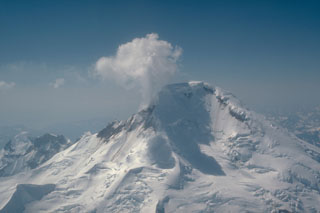Report on Iliamna (United States) — December 1978
Scientific Event Alert Network Bulletin, vol. 3, no. 12 (December 1978)
Managing Editor: David Squires.
Iliamna (United States) Steam emissions for 2.5 hours
Please cite this report as:
Global Volcanism Program, 1978. Report on Iliamna (United States) (Squires, D., ed.). Scientific Event Alert Network Bulletin, 3:12. Smithsonian Institution. https://doi.org/10.5479/si.GVP.SEAN197812-313020
Iliamna
United States
60.032°N, 153.09°W; summit elev. 3053 m
All times are local (unless otherwise noted)
A brief steam emission began at about 1050 on 7 November. Puffs of steam, ejected every 1-5 minutes, rose an estimated 3 km above the summit. No ash was visible in the steam puffs. The activity ended at about 1330. Iliamna's last reported activity occurred 1952-53. A USGS seismic station 20 km NNE of Iliamna recorded no unusual seismicity.
Geological Summary. Iliamna is a prominentglacier-covered stratovolcano in Lake Clark National Park on the western side of Cook Inlet, about 225 km SW of Anchorage. Its flat-topped summit is flanked on the south, along a 5-km-long ridge, by the prominent North and South Twin Peaks, satellitic lava dome complexes. The Johnson Glacier dome complex lies on the NE flank. Steep headwalls on the S and E flanks expose an inaccessible cross-section of the volcano. Major glaciers radiate from the summit, and valleys below the summit contain debris-avalanche and lahar deposits. Only a few major Holocene explosive eruptions have occurred from the deeply dissected volcano, which lacks a distinct crater. Most of the reports of historical eruptions may represent plumes from vigorous fumaroles E and SE of the summit, which are often mistaken for eruption columns (Miller et al., 1998). Eruptions producing pyroclastic flows have been dated at as recent as about 300 and 140 years ago, and elevated seismicity accompanying dike emplacement beneath the volcano was recorded in 1996.
Information Contacts: J. Proffett, Anaconda Co., Anchorage; J. Kienle, Univ. of Alaska; J. Lahr, USGS, Menlo Park, CA.

